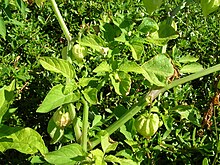Physalis angulata
Appearance
| Physalis angulata | |
|---|---|

| |
| Cutleaf groundcherry | |
| Scientific classification | |
| Kingdom: | Plantae |
| Clade: | Tracheophytes |
| Clade: | Angiosperms |
| Clade: | Eudicots |
| Clade: | Asterids |
| Order: | Solanales |
| Family: | Solanaceae |
| Genus: | Physalis |
| Species: | P. angulata
|
| Binomial name | |
| Physalis angulata | |
| Synonyms[1] | |
| |
Physalis angulata is an erect, herbaceous, annual plant belonging to the nightshade family Solanaceae. It reproduces by seed. Its leaves are dark green and roughly oval, often with tooth shapes around the edge. The flowers are five-sided and pale yellow; the yellow-orange fruits are born inside a balloon-like calyx. It is native to the Americas, but is now widely distributed and naturalized in tropical and subtropical regions worldwide.
It is related to, but not to be confused with Physalis peruviana, the Cape gooseberry, a fruit native to, and cultivated in the western Andes, and exported worldwide.
Vernacular names
- English common names include: angular winter cherry,[2] balloon cherry,[2] cutleaf groundcherry,[2][3] gooseberry,[2] hogweed,[2] wild tomato, camapu, and occasionally other common names for the genus Physalis.
- In Malayalam it is known as njottanjodiyan (ഞൊട്ടാഞൊടിയൻ) and mottaampuli(മൊട്ടാമ്പുളി).
- In Indonesian it is known as ceplukan or ciplukan.
- In Suriname it is known as batoto wiwiri.
References
- ^ "The Plant List: A Working List of All Plant Species". Retrieved 14 July 2014.
- ^ a b c d e "Physalis angulata". Germplasm Resources Information Network. Agricultural Research Service, United States Department of Agriculture. Retrieved 14 July 2014.
- ^ Physalis angulata (USDA)
External links
- Physalis angulata in West African plants – A Photo Guide.
- "Physalis angulata L." Atlas of Living Australia.
![]() Media related to Physalis angulata at Wikimedia Commons
Media related to Physalis angulata at Wikimedia Commons
